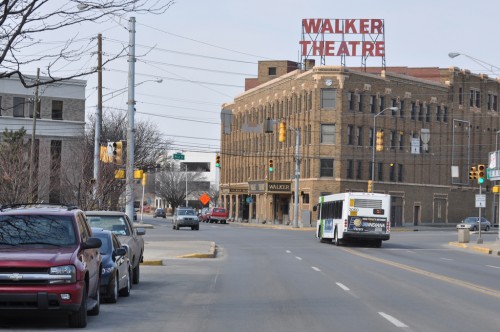
If you are a regular visitor to this site, then you are undoubtedly familiar with our complete and undivided support for improvements to our region’s transit system. Sure, we all have specific talking points that we feel would represent SMARTER choices, but at the heart is this unifying vision of improved transit options. As advocates, we can lose sight of how obvious this is to us from time to time; and conversely, how oblivious others may be to it. So how do we address this? A simple education at the basic level is needed. So here are a few reasons why supporting Indyconnect is important to improving our region’s transit.
Improving the Current Bus System
IndyGO has been operating on a skeleton budget for a number of years, supported primarily by local property taxes. Low service based on low financial support has driven a perception that IndyGO operates as a failing business unit due to poor management. IndyGO operates on such a low budget, that compared to other cities, Indianapolis consistently ranks near 100th in major American metro’s for spending on transit. What this translates to is poor job access for people who do not own a car; whether that is by choice or neccesity. Poor job access alone is a gateway into a breakdown of numerous things. Low income citizen services. Poor economic sustainability. No incentive for commercial investment along transit corridors. This year, IndyGO announced that due to a shortage of funding, it was planning on reducing service. The already sparce frequency (approx 30 minutes) would have been cut to an hour at peak times. Luckily, the city stepped in to provide some financing options to stave this off for at least another year at which point other options will be sought. These are the facts, so at what point does the blame fall on civic leaders for not providing better options for transit financing?
The Drawbacks in our Current System
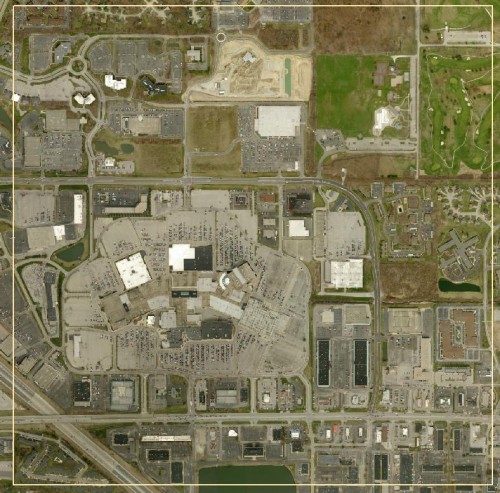
Currently, the city of Indianapolis basically requires residents to own one car per adult. Not only is this unfair to the less wealthy among us, it’s environmentally unsustainable, requires our dependence on large quantities of oil from places that don’t like us, and strains our infrastructure. Road infrastructure is an inadequate solution for transportation problems as it allows citizens to spread out across the land, leaving behind both the inner city and inner ring suburban areas to fend for themselves with a decreased population and tax base. Meanwhile, displaced residents in the border counties still get to use our city’s streets to get to work or an event, at no cost to them.Â
From aesthetic point of view, road and parking infrastructure is unattractive, and the older it gets, the worse it looks. It’s not hard to see the difficulty the city will have in repopulating these wide-open and desolate spaces. Lafayette Square has been successful in attracting a population of recent immigrants. Other places in the city have been less so. What is the strategy to save these places? Is there one?
The High Cost of Owning a Car
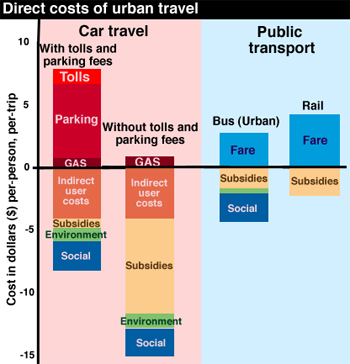
Perhaps the largest, but frighteningly little-talked about problem is that automobile infrastructure is expensive to build and maintain. Any new building project in the city is required to include a parking lot, or apply for a variance. The application process adds time and cost to the project. This discourages true urban development. Additionally, parking is a huge policy problem which a city must get right or the local economy is absolutely distorted. Our Indianapolis based parking system shifts costs from drivers onto the general public (see graphic). If parking policies are done correctly then a lot of other things start to make sense (like mass transit).Â
Even without subsidized parking or mandated parking requirements, the cost of providing parking to businesses in urban areas is very high.  Other researchers have concluded that parking requirements (say 4 per 1000 LSF) increase the cost of urban development by up to 50%. The Indianapolis requirement to provide 2 / 800 LSF for CBD 2 zoning would increase costs ~ 25%, and that is why parking garages or loans are often subsidized by the city government to make up the cost. We all want parking accessibility, and the city knows that surface lots are horrible, but we can’t afford to pay for parking unless the costs are hidden or taken out in taxes. Assuming that space is even available, a 1:1 relationship is usually needed for Leasable SF vs. Parking SF. Underground parking is usually an option, but increases the cost of construction even further, making it an unattractive solution. Thus the typical solution is to put a parking garage on every block, which spreads out the city and limits density. It also mandates a lower value for real estate, because land that could be leased at rates up to $30/LSF is now being used as parking which returns $12/LSF, and in effect devalues the urban area by 20% to 33%. This means economic activity and tax revenues also fall.Â
The benefit of mass transit is that instead of providing on-site or near site parking at every location, a system-wide solution can be used which provides mobility and accessibility over a wide area. Thus, parking requirements can be eliminated and developers can base their parking decisions on local market values. In urban areas this can lower costs of parking from 33% to 11% of overall project costs and eliminate the sprawling effects of parking requirements near TOD stations. Of course, once you get rid of the need to park, you can also reduce the need to drive and eliminate a significant amount of the auto-infrastructure in the urban area.
An anecdote about personal automobile spending habits
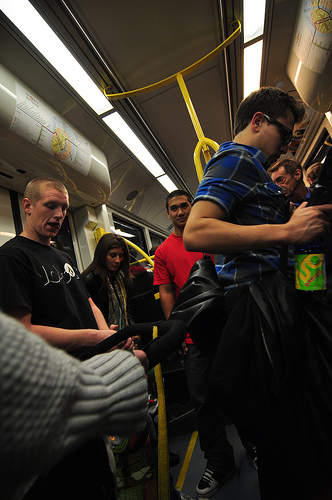
I’d like to wrap up with a final thought on personal transportation finance. The next time you are doing a budget check, add up the amount of money spent on insurance. Gas. Car payment. Oil changes. Parking. If one adds these costs up, and compared them to a monthly transit pass, the proportion is huge.
Why is investment in transit important for Indianapolis? It provides a gateway for smarter economic development. It helps shape a safer and better looking city. It creates a progressive image to the rest of the world. It represents a more efficient investment in not just our transportation system, but in a system that better influences our built environment.
—
Editor’s Note: This article was written with input from Kevin & Graeme as well. Thanks guys!
—
Editor’s Note: This picture comes from frequent commentor Chris Barnett regarding population density in Indy as of the 2000 Census
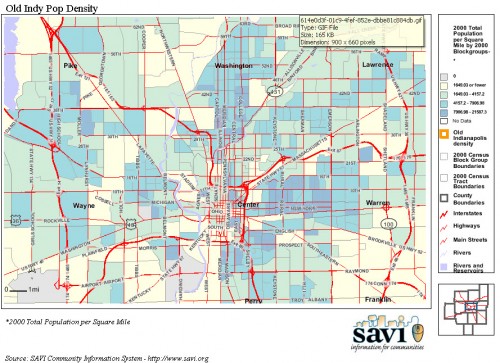
Good writing. I was stationed at Ft. Benjamin Harrison for just long enough to see that in spite of some nice people living in Indianapolis, that it was headed in an urban planning direction that would not attract me back there when I got out of the service. I did think that “Naptown” as the soldiers called it would wake up some day, so I wish you well in doing that.
This seemed especially sad when I learned about the history of the city and realized that it once had a good transit system and was considered to be well laid out and I could see once was an attractive place.
Outstanding post, Curt. A friend of mine is currently in Seattle visiting and he wrote me a note that said the following, “Indianapolis is known for hospitality–we should be – that is where we’ve put a lions share of our money-for visitors. Seattle is hospitable but visitors join the urban culture of this place; they don’t seem to be trying to ask the balance of the population to join in on the culture scene; its just there.” This should be about a thousand little cultural shifts in which we all take part. We have an opportunity every day to choose our identity as a city. I don’t want to be Seattle – or Portland – or Denver – or Barcelona. I want to be the best Indianapolis that we can be!
Great post! There’s some good info here that I haven’t seen before. Thanks!
“Sure, we all have specific talking points that we feel would represent SMARTER choices, but at the heart is this unifying vision of improved transit options.”
Curt – I totally agree. As advocates, it is so important that we unify and rally behind the Indy Connect plan for all the reasons you so eloquently outline above (and more)!
I really try hard to stay measured and realistic about what Indianapolis is and who policymakers and shot callers are. It’s very frustrating!
My wish is that we accept the progress we can make now, but still protect the flame of our vision of what Indianapolis could be. As transit activists we know what this is!!
In addition to a change in the zoning ordinance requiring parking downtown, I think there is another useful, though politically unpalatable, possibility. Indianapolis should find additional funding for its mass transit system by placing a levy on all non-residential parking downtown. A dollar per day per spot over 60,000 parking spots would yield $15 to $16 million per year. It would increase the cost of parking downtown, which would have the effect of 1) decreasing the demand for parking; 2) increasing incentives to carpool; 3) increasing incentives to ride public transit, which would increase transit revenue; and 4) shifting some of the burden of paying for public transit onto suburban commuters rather than downtown residents. I’m not saying it’s perfect, or even politically possible at this point, but it’s worth batting aroung.
Installing LRT or BRT isn’t going to automatically densify Indy. The density has to be there to justify it. Otherwise, it’s just a commuter service from the airport or Fishers.
Indianapolis doesn’t have the urban policy Portland has that would create density. Instead of an urban growth boundary like Portland, we reorganize or remove political lines to make it easier to sprawl.
Indianapolis does not need to “create density” to support LRT or BRT. A good base of population density and urban form already exists on the Washington St. corridor from west of IUPUI to Irvington, and from Fountain Square to Broad Ripple via downtown/Methodist Hospital/The Children’s Museum.
.
I can’t post the visual data (a map of population density in the “old city” areas of Indy) in a response box, but I will email it to Curtis for him to post in the next couple of days.
Although I was opposed to the recent parking deal (not conceptually…just thought they made a bad deal), there is a silver lining — parking rates will soon go up.
I added the map and generally agree with Chris. Randy, you are right that BRT or LRT will not automatically densify Indy. However, continuing to build auto-oriented developments will not stop the bleeding that is currently happening. Yes, a zoning/land use plan needs put into affect that will encourage proper development. If you’ve hung around here enough, you will get the sense that all of the writers know this. Indy was recently awarded money from HUD to study different zoning patterns in 3 neighborhoods and is already working on Form Based Coding in the Broad Ripple Village that should be unveiled in the next 6-12 months. Those projects should drive some changes to the entire zoning policies of Indianapolis so that the parking requirements laid out in this article can be affected differently; more efficiently.
With our goals and overiding theme to grown the convention center business in Indianapolis, it is crazy to me how we spent $1 billion on a new airport, approximatley $600 million on a new stadium, and several hudred million expanding the convention center, and we couldn’t squeeze enough out of all those budgets to get a rail connection between the airport and downtown. This seems like a big contradiction to making the convention center business work, and a lost opportunity to kick off the mass transit system.
Exactly. Just imagine what impression a visitor would take away about Indy if all they did was fly into our shiny new airport, take our shiny new light rail into downtown, go to meetings in our shiny new convention center, and stay overnight in one of our shiny new hotels.
Those are all good arguments. Even the original indyconnect plan laid out such a plan. For whatever reason when it comes to mass transit, it be ones difficult to dedicate the money it takes to make it happen
‘ The requirements for being cardholder should be simple and easy;.
‘ Most of the people are illiterate; they do not know how to
use the credit card;. He has also won several national
an international awards.